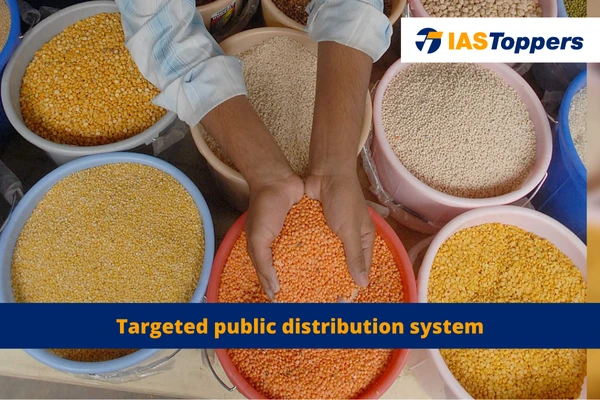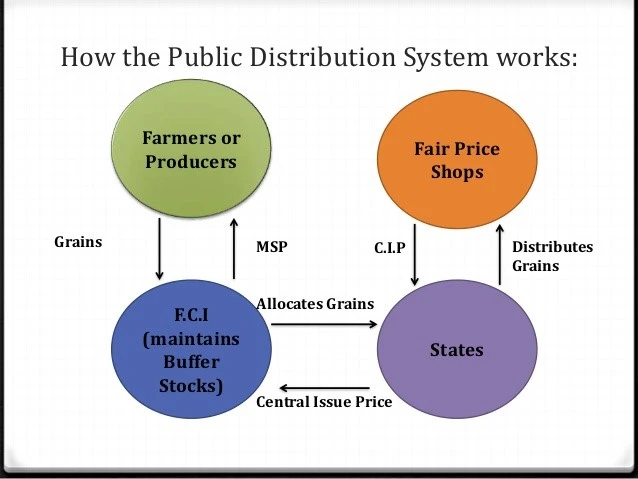Public Distribution System is a food security initiative that aims to provide essential food and non-food items to the poor population of India at subsidized rates. In this article, you will learn about public distribution system, definition, objectives of public distribution system, targeted public distribution system in India, Antyodaya Anna Yojana, Revamped Public Distribution System, benefits, drawbacks of Public Distribution System, etc.
This article will provide key insights for GS Paper-III Economy section of UPSC IAS Exam.
Table of Content
- What is Public Distribution System?
- How does Public Distribution System works?
- What is Targeted Public Distribution System?
- Objectives of Targeted Public Distribution System
- Functioning of Targeted Public Distribution System in India
- History of Targeted Public Distribution System
- Reforms in Targeted Public Distribution System
- Antyodaya Anna Yojana
- Revamped Public Distribution System
- Advantages of Public Distribution System
- Disadvantages of Public Distribution System
- Conclusion
- Frequently Asked Questions
- Reference
What is Public Distribution System?
- The Public Distribution System is a food security initiative that aims to provide essential food and non-food items to the poor population of India at subsidized rates.
- The Public Distribution System is implemented by the Ministry of Consumer Affairs, Food and Public Distribution.
- Types of Public Distribution System: Revamped Public Distribution System (RPDS), Targeted Public Distribution System (TPDS) and Antyodaya Anna Yojana (AAY).
How does Public Distribution System works?
- The Public Distribution System operates through a network of fair price shops or ration shops located in various states throughout the country.
- The fair price shops mainly distribute staple food grains like wheat, rice, sugar, and essential fuels.
- The Food Corporation of India is responsible for procuring the items and managing the PDS.
What is Targeted Public Distribution System?
- Targeted Public Distribution System is a programme of Government of India that aims to reduce poverty by delivering minimum requirements of food grains at subsidized prices.
- The National Food Security Act, 2013 (NFSA) provided for coverage of up to 75% of the rural population and up to 50% of the urban population to receive subsidized foodgrains.
- The system categorises Indian households as Below the Poverty Line and Above the Poverty Line.
Objectives of Targeted Public Distribution System
- The program’s aim was to benefit approx. 6 crore poor families using an annual allocation of around 72 lakh tonnes of food grains.
Functioning of Targeted Public Distribution System in India
- The State Government were required to establish reliable procedures for identifying the poor and transparently distribute food grains at the level of Fair Price Shop (FPS).
- States can determine the eligibility of beneficiaries based on state-specific poverty estimates given by the Planning Commission’s “Expert Group on estimation of proportion and number of poor”.
- The allotment of food grains to States and Union Territories (UTs) were done on the basis of the average consumption over the past ten years under the TPDS.
- The States and UTs have to determine the end retail prices under TPDS, by considering the margins for wholesalers, retailers, transportation charges, and local taxes.
- The allocation level in quantity for APL families had remained unchanged after the TPDS introduction, but Central Issue Prices (CIPs) for APL were set at 100% of the economiccost.
- This made the entire consumer subsidy directed towards benefitting the BPL population.
History of Targeted Public Distribution System
- Targeted Public Distribution System was started in India in 1997 to assist the undernourished and poor population.
- A “transitory allocation” of food grains amounting to 103 lakh tonnesannually were also provided to states, exceeding the requirement for Below Poverty Line (BPL) families.
- This allocation ensured that the population Above the Poverty Line (APL) continued to receive subsidized food grains without a sudden withdrawal of benefits.
Implementation of Targeted Public Distribution System after 2000:
- Due to improvement in conditions of poor in matter of nutrition, the Government of India had raised the allocation for BPL families from 10 kg to 20 kg per family per month, at 50% of the economic cost.
- The transitory allocation was priced higher than the BPL quota but were still subsidized.
- The CIPs for BPL, AAY, and APL have not been revised since 2002, despite increase in procurement costs.
- The number of BPL families was adjusted based on the population projections of the Registrar General, instead of the previous projections from 1995.
- This adjustment resulted in increase in coverage of BPL families.
2001:
- The restriction of not exceeding 50 paise perkg over the CIP for BPL families was removed in 2001.
- This provided flexibility to States and UTs to settle the retail issue prices for food grains under TPDS.
Reforms in Targeted Public Distribution System
- 100% digitized ration cards or beneficiaries’ data under NFSA in all States/UTs.
- Implementation of One Nation One Ration card throughout the country under which beneficiaries can get their subsidized foodgrains and products from any Fair Price Shop in in India irrespective of their place of residence.
- About 99.8% Fair Price Shops in the country are automated using electronic Point of Sale (ePoS) devices for transparent distribution of subsidized foodgrains to beneficiaries.
- Nearly 90% biometrically or Aadhaar enabled Public Distribution System (AePDS) allocates monthly foodgrains via States and UTs under NFSA.
- The “Online Storage Management (OSM)” is a digital system that helps to improve operational efficiency in the storage, movement, and distribution of food grains.
Antyodaya Anna Yojana
- It was launched in 2000 in order to extend the coverage of food grains to the most vulnerable population.
- This initiative mainly targets the poorest of the poor households within the Below Poverty Line (BPL) category under the Targeted Public Distribution System.
- Under this scheme, one crore such families are identified and provided the food grains at highly subsidized rates which is wheat at Rs. 2/kg and rice at Rs. 3/kg.
- The States and union territories (UTs) are supposed to bear the distribution costs, including the margin for dealers, retailers and transportation expenses.
- By passing on the entire food subsidy to the consumers, the scheme ensures that those in need receive the maximum benefits.
Revamped Public Distribution System
- It was launched in June 1992 to extend the reach of subsidised food and benefits of Public Distribution System to remote and underserved areas where a significant population of the poor resides.
- Revamped Public Distribution System (RPDS) targets 1775 blocks identified in consultation with state governments including the regions covered by specific programs such as the Drought Prone Area Programme (DPAP), Integrated Tribal Development Projects (ITDP), Desert Development Programme (DDP), and Designated Hill Areas (DHA).
- Under the RPDS, food grains for distribution were provided to states at a price lower than the 50 paise from the Central Issue Price.
- Each eligible cardholder can receive up to 20 kg of food grains.
- The RPDS employs an area-based approach to ensure effective delivery of PDS commodities, where state governments have to ensure doorstep delivery to Fair Price Shops in the designated areas.
- Additional measures included the provision of ration cards to previously excluded families, establishment of additional Fair Price Shops, increased storage capacity, and the inclusion of supplementary commodities such as tea, salt, etc., for distribution through the PDS outlets.
Advantages of Public Distribution System
- PDS helps in alleviating the poverty level of India.
- PDS provides food security to poor people of India.
- PDS ensures that no person dies because of hunger.
- PDS helps in stabilizing food prices.
- PDS ensures the availability of food at affordable and subsidized rates.
Disadvantages of Public Distribution System
- Many times, substandard food grains are provided at ration shops.
- Many FPS Dealers engages swaps the inferior stock for the high-quality supplies received from the Food Corporation of India with the private shopkeepers.
- Illicit fair price shop owners have been discovered creating a large number of counterfeit ration cards to sell food grains in the open market.
- Due to the meagre salaries of FPS dealers, many of them resort to malpractices, such as illegal diversions of commodities, hoarding, and engaging in black market activities.
- In different states, the identification of eligible households and the distribution of PDS services have been inconsistent and diverse.
- The regional allocation and coverage of Fair Price Shops are not up to the mark as they fail to achieve the core objective of stabilizing prices for essential commodities.
- The absence of clear criteria to determine which families fall above or below the poverty line creates loophole for corruption in the PDS system.
- The restriction on purchasing the allotted food stock in instalments hampers the efficient functioning of the PDS families in India.
- Many families of below the poverty line face challenges in acquiring ration cards, either because of being a seasonal migrant worker or residing in unauthorized colonies.
- Limited information on ration card benefits has discouraged eligible families from registering for new cards.
- Insufficient supervision of FPS and a lack of accountability has mad eth system exploitative at the hands of middlemen, who diverts the major portion of the allocated stock to earn profits.
Conclusion
Importance of public distribution system in India lies in the fact that it ensures the availability and accessibility of essential commodities to the most vulnerable sections of society. Success of Public Distribution System (PDS) was evident during the COVID-19 pandemic when it helped many Below the Poverty Line (BPL) category to have a full plate of nutrition.
Ref:
FAQs(Frequently Asked Questions)
What do you mean by public distribution system?
Public Distribution System is associated with food security initiative that aims to provide essential food and non-food items to the poor population of India at subsidized rates.
How does public distribution system ensure food security in India?
The Public Distribution System operates through a network of fair price shops that distributes staple food grains like wheat, rice, sugar, and essential fuels.
What is Revamped Public Distribution System?
The Revamped Public Distribution System extends the reach of subsidised food and benefits of Public Distribution System to remote and underserved areas where a significant population of the poor resides.
What is Antyodaya Anna Yojana?
Antyodaya Anna Yojana extends the coverage of food grains to the most vulnerable population of India.



